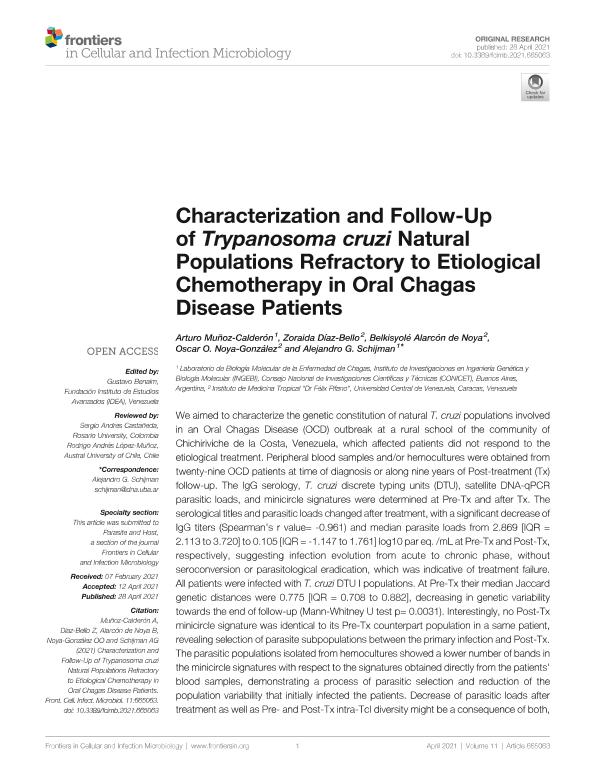Artículo
Characterization and follow-up of Trypanosoma cruzi natural populations refractory to etiological chemotherapy in oral chagas disease patients
Muñoz Calderon, Arturo Alejandro ; Díaz Bello, Zoraida; Alarcón de Noya, Belkisyolé; Noya González, Oscar O.; Schijman, Alejandro Gabriel
; Díaz Bello, Zoraida; Alarcón de Noya, Belkisyolé; Noya González, Oscar O.; Schijman, Alejandro Gabriel
 ; Díaz Bello, Zoraida; Alarcón de Noya, Belkisyolé; Noya González, Oscar O.; Schijman, Alejandro Gabriel
; Díaz Bello, Zoraida; Alarcón de Noya, Belkisyolé; Noya González, Oscar O.; Schijman, Alejandro Gabriel
Fecha de publicación:
28/04/2021
Editorial:
Frontiers Media S.A.
Revista:
Frontiers in Cellular and Infection Microbiology
ISSN:
2235-2988
Idioma:
Inglés
Tipo de recurso:
Artículo publicado
Clasificación temática:
Resumen
We aimed to characterize the genetic constitution of natural T. cruzi populations involved in an Oral Chagas Disease (OCD) outbreak at a rural school of the community of Chichiriviche de la Costa, Venezuela, which affected patients did not respond to the etiological treatment. Peripheral blood samples and/or hemocultures were obtained from twenty-nine OCD patients at time of diagnosis or along nine years of Post-treatment (Tx) follow-up. The IgG serology, T. cruzi discrete typing units (DTU), satellite DNA-qPCR parasitic loads, and minicircle signatures were determined at Pre-Tx and after Tx. The serological titles and parasitic loads changed after treatment, with a significant decrease of IgG titers (Spearman’s r value= -0.961) and median parasite loads from 2.869 [IQR = 2.113 to 3.720] to 0.105 [IQR = -1.147 to 1.761] log10 par eq. /mL at Pre-Tx and Post-Tx, respectively, suggesting infection evolution from acute to chronic phase, without seroconversion or parasitological eradication, which was indicative of treatment failure. All patients were infected with T. cruzi DTU I populations. At Pre-Tx their median Jaccard genetic distances were 0.775 [IQR = 0.708 to 0.882], decreasing in genetic variability towards the end of follow-up (Mann-Whitney U test p= 0.0031). Interestingly, no Post-Tx minicircle signature was identical to its Pre-Tx counterpart population in a same patient, revealing selection of parasite subpopulations between the primary infection and Post-Tx. The parasitic populations isolated from hemocultures showed a lower number of bands in the minicircle signatures with respect to the signatures obtained directly from the patients’ blood samples, demonstrating a process of parasitic selection and reduction of the population variability that initially infected the patients. Decrease of parasitic loads after treatment as well as Pre- and Post-Tx intra-TcI diversity might be a consequence of both, natural evolution of the acute infection to the chronic phase and persistence of refractory populations due to Tx selection.
Archivos asociados
Licencia
Identificadores
Colecciones
Articulos(INGEBI)
Articulos de INST.DE INVEST.EN ING.GENETICA Y BIOL.MOLECULAR "DR. HECTOR N TORRES"
Articulos de INST.DE INVEST.EN ING.GENETICA Y BIOL.MOLECULAR "DR. HECTOR N TORRES"
Citación
Muñoz Calderon, Arturo Alejandro; Díaz Bello, Zoraida; Alarcón de Noya, Belkisyolé; Noya González, Oscar O.; Schijman, Alejandro Gabriel; Characterization and follow-up of Trypanosoma cruzi natural populations refractory to etiological chemotherapy in oral chagas disease patients; Frontiers Media S.A.; Frontiers in Cellular and Infection Microbiology; 11; 28-4-2021; 1-12
Compartir
Altmétricas



